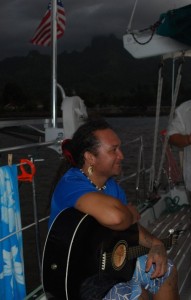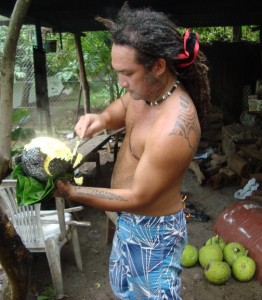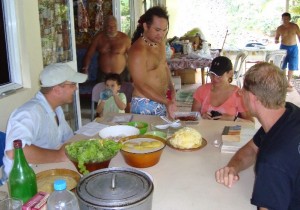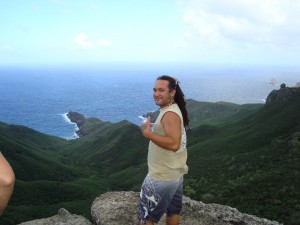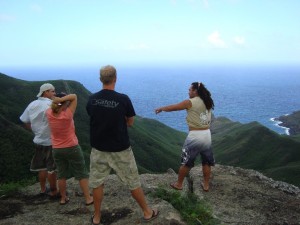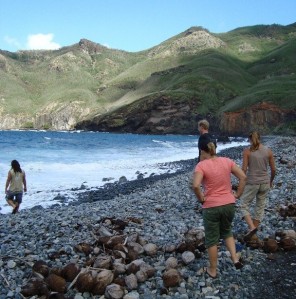Because we haven’t been able to post a picture of Moana, I’ll try a quick description. He’s 32, no more than 5′ 8″, strong, athletic, and stocky. He has dreadlocks that come below his shoulders that he usually wears pulled back in a bunch, and a large prized ear-ring with three long, curved sharks teeth that he received as payment for a traditional Marquesan tattoo (one of his jobs is as a local traditional tattoo artist). He has a large, round face that is tattooed a bit on the left side and is almost always smiling or laughing. When he’s hanging out with us, he’s often cracking jokes, telling stories, or answering our questions about the island. He’s also an accomplished traditional dancer who dances as part of the local group that entertains the boat with tourists. He was selected along with two other guys and one girl to travel to France to represent the Marquesas for a month as part of an international dance exhibition/instruction project (when is the last time you heard of the US government flying in dancers from Guam, Puerto Rico, etc. for a cultural exchange?). He was proud of that but didn’t care much for France, where he felt that people live a far too rushed, hurried, scheduled, and work-oriented lifestyle. (We tried to explain that people from the US often feel the French are lazy lay-abouts, but he wasn’t impressed).
After reading Herman Melville’s “Typee” about his time as a deserter/captive of the Marquesan tribe of the Tai Pi valley in Nuku Hiva, I was anxious to try their traditional “poi poi” (Melville) / “Popoi” (po-POI as we’ve heard it) dish made of fermented breadfruit. To our delight, Moana invited us over for a traditional lunch (the word kai-kai is associated with good food and meals of this sort) with his family yesterday. Lunch required 7 coconuts, a chicken, plenty of breadfruit, and at least a couple fish. About 30 minutes after we arrived we found the table covered with: chicken with coconut milk and cucumber (Moana made a point of letting us know that this was not a “store chicken” from a package, it had evidently met its end earlier in the morning), poisson cru (fresh fish poached in lime juice with coconut milk as well), a bowl of raw fish, popoi (sort of like a thick, bitter-tasting yellow pudding), KAA-kuu (breadfruit worked into the consistency of a very thick dough and then covered in a bath of coconut milk), uru (I think this is just the Marquesan word for breadfruit, but as a dish it appeared to simply be cooked breadfruit), fresh bananas covered with some sort of brown sauce, banana fritters made of bananas mixed with flour and fried, and salad with excellent homemade dressing (just for Dallas the vegetarian). Quite a kai-kai indeed. Moana and his parents prepared the food, and some of his extended family were there to enjoy it with us. Apparently the tradition in the Marquesas is for the guests and children to eat their fill first and then for the host adults to have a turn at the table. This is definitely not the arrangement we would have preferred, but it is the custom so we obliged.
We talked for a while after lunch, and then we got a great surprise. Moana borrowed his brother’s truck to take an Air Tahiti plane ticket to his sister in Ho Hoi and invited us to come along. Ho Hoi is a valley on the east side of the island that is too exposed to visit by boat. The population there seems to be even smaller than Hapatoni. Like Hapatoni, it is too small to have a store, but does have a new small school that Moana has been helping to build. The drive through the mountains was spectacular. We first stopped the truck when Moana recognized one of his older brothers riding in the bed of an approaching truck. He lives in Ho Hoi and was on his way to Hakahau for tonight’s festivities but jumped into the bed of our truck after a few words were exchanged in Marquesan. Our next stop was a turn-out overlooking the valley between Hakahau and Ho Hoi. I can’t recall the name, but it started with Haka (which is also the name of a traditional island dance done at weddings, etc.) and Moana referred to it as the valley of the kings. It was a beautiful valley, especially when viewed from high up on the side of the mountain. Apparently important chiefs lived here at the time that missionaries began arriving. Moana’s version of the valley’s history went something like this, “Before, many chiefs live here. When missionaries come, church, many prayer, ugh. Chiefs say OK, we go to Hakahau, take people to Hakahau.” (Apparently tired by the missionaries, the chiefs moved the people to the next valley.) “Before that, when missionaries come, we eat them.” (He smiles and laughs at the fate of the previous missionaries). Not being something traditionally Marquesan, Moana is not a fan of Western religion, although his parents and at least one of his brothers are devout Catholics.
The next stop along the way was “the viewpoint”. I’ll try to describe it, but eventually you’ll get to see a couple pictures. We didn’t know we were going, so we only had the small camera, which turned out to be quite a shame. We stopped the truck by the side of the road and followed a small foot path for 50-100 feet until it ended on a sort of U-shaped ledge of large rocks that jutted out over the edge of a large valley maybe 1000 feet below. The tradewinds off of the Pacific were blowing up the mountain at 25-30 knots, and it felt as though if they were to stop blowing, you might be at risk of falling off the ledge. I’m not generally bothered too much by heights, but to be perched on a ledge 1000 feet or so above the valley floor with a strong wind blowing by definitely had a physiological effect.
The island of Ua Pou, like the other inhabited islands of the Marquesas, is made of large volcanic mountains with valleys between the peaks that are in the middle of the island and the high ridges that radiate outward from the peaks to the ocean or along the “backbone” of a longer islands. There is some variation, but generally, each valley has a bay, and depending on the difficulty of reaching the next valley, it seems the people of each valley were sort of a separate tribe in the old days. The steep ridge to the right of this valley was topped by two very large and round rock formations lightly covered with brush. Behind the ledge to our left was a sheer cliff dropping hundreds of feet that was formed more or less into three large shapes. The ridge to our left was just as steep as the one to the right and both stretched out into the Pacific, where they bordered a cliff-lined bay. Moana told us a story about how he and a friend had once come to this bay from the neighboring bay of Ho Hoi to go fishing and were unable to return due to the rough sea state. Instead, they walked up this large valley, caught and killed five wild chickens on the way, and returned to Ho Hoi by hiking over the ridge. We were in no hurry to leave the vista, but eventually we headed on to Ho Hoi.
After a short stop at Moana’s sister’s house, we headed to the beach. The beach was made of rocks with no sand. Our ears were filled by the familiar crackling sound of the ocean surf receding from the rocks on the beach, the sound of the tradewind-driven waves crashing on the rocks, and the sound of the trades themselves as there were accelerated by the narrow bay and steep mountainside behind. I don’t know if this is the case everywhere here in the Marquesas, but we noticed for the first time that the rocks on the beach that seem to appear a chalky gray when dry and a deep black when wet are actually many rocks of different colors that are only visible when wet. There were deep green ones, light red and dark red ones, and yellowish ones. At the south edge of the choppy bay was a group half a dozen or so men that looked like fathers and sons. They were cutting up and eating raw fish and had apparently just returned from fishing in the outrigger canoes that were resting nearby.
After a half an hour or so on the beach, we got back into the truck and headed back to Hakahau for Friday night’s festivities. Apparently this is still an extension of the Bastille Day celebrations which are more or less a month long. Tonight’s attraction would be traditional dancing by the local women and girls whom we had seen practicing in an open-air public building on the beach across from the boat. Moana wasn’t too excited as the dancing would be Tahitian-style instead of Marquesan, but we wanted to see it anyway, so we enjoyed a nice dinner on Tim while we watched the dancing. The local restaurants here are the same style as the ones in Atuona — there are half a dozen or so, mostly open-air restaurants, usually with 2-3 inside a tin-roofed “building”. The ground serves as the floor, and there are simply tables with decorative tablecloths and plastic chairs. The restaurants are arranged in a sort of large U-shape, so that a public event can occur that is generally visible to anyone in any of the restaurants. Here in Hakahau, most of the open area was covered by a tent where the women and girls danced to recorded music. The dancing here seems to have suffered a bit from the years of being banned and the competing interests of a more modern existence, but it was interesting nonetheless. The youngest group of girls was about 12 and the largest group included middle-aged women.
There are a lot of good Moana quotes from the day, but I’ll try to relate a few them. He explained that it is OK on Ua Pou to drive home after a party because one can drive slowly, at a speed commensurate with one’s ability at the time. Referring to the gears of a manual transmission, he said, “Drive home is OK. Not drive fast. Go 1, go 2. Aahhhh yes. It’s good. It’s OK.”
He had a lot to say about the transition from a sustenance existence to a buy and sell economy. It is pretty interesting to note that in the past these islands supported a fairly large population with enough surplus to sustain religious construction, priests, chiefs, and war, but now need French support to sustain even the small population that exists today. “Before,” he said, “You take (reaching out his hands as if grabbing fruit from a tree), you eat. You hungry, you take. You no take (hands under his armpits), you no eat. Take fish, take birds, hunt goat, hunt pig, take breadfruit, take coco(nut), no buy. Now, want fruit, you buy. Want fish, you buy. Want chicken, buy.” He’s not too happy with his two older nephews, who like cars and music, but won’t go hunt goats. He does feel there’s some hope for the youngest nephew in that family, though, who will go fishing and goat hunting with him.
An interesting side note to this whole conversation was his mention of the way children’s behavior had changed. In the old days, kids started supplementing the family’s food intake at a young age, especially if they were hungry for something in particular (fish, wild goat, etc.). At 8 or 9 Moana used to catch octopus bare-handed to bring home for a treat. Now the kids are dependent on food provided by the parents, and because much of the food is purchased they have no role but to be fed. Even here in the big city (pop. 1096) of Hakahau, people still have chickens, pigs, and fruit trees at home, but with occasional fairly isolated valleys, the Marquesas does make an interesting place to observe both near-sustenance and almost complete buy-sell economies.
With the steep and muddy mountain roads on the drive to and from Ho Hoi, Moana was concentrating hard on driving and a couple of times couldn’t answer a question to our satisfaction. Even with our rough French and his rough English, it often takes several attempts to state a question and to confirm that it is indeed understood by both parties. The first time this happened, he drove on, and then when a came to a bend in a road with a spot to pull over he stopped the truck, turned toward the backseat, and said, “OK, Lauren. What is the question?” There aren’t too many cultures where someone would take you on a tour across their island without expecting anything in return and then go to the trouble of pulling the truck over on a steep and muddy mountain road so they can properly answer your question. When the same thing happened again, about 10 minutes later as we were nearing town, he laughed, “Sorry Wes, I DRIVE. Haha. I DRIVE.”
Moana’s signature in our guest book includes the words “Te Henua Enana.” It’s the name for the Marquesas in the local language and means “the land of men” — Te Henua (the world) Enana (men).
We’re going to try to be here in Hakahau on Tuesday when the Ara Nui arrives from Tahiti. It’s one of the ships that serves as cargo, passenger, and tourist vessel. When it stops, the local artisans bring out their wares to sell and Moana will be doing a traditional dance for the tourists with other Marquesans and pahu (drums) at the pae pae (traditional meeting place) that we’d like to see. In the meantime, we may stay here or go visit the west side of the island.


